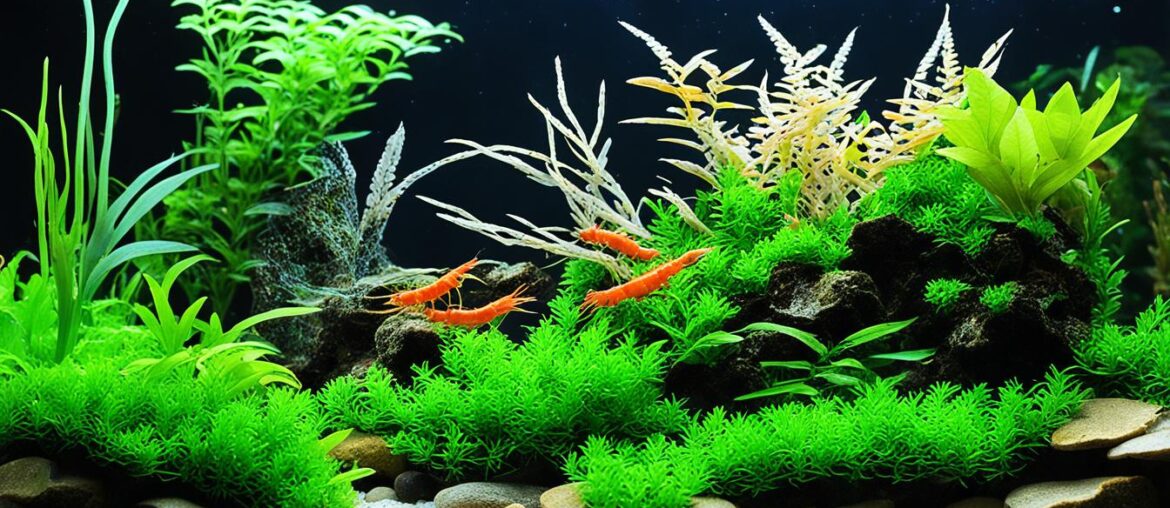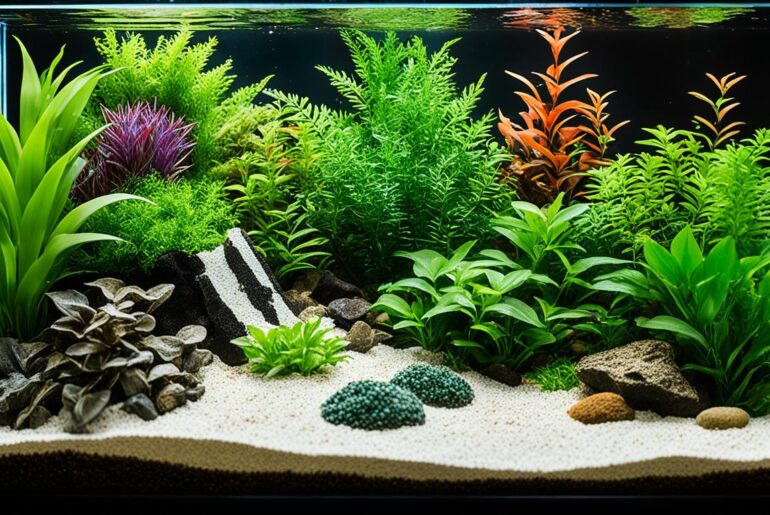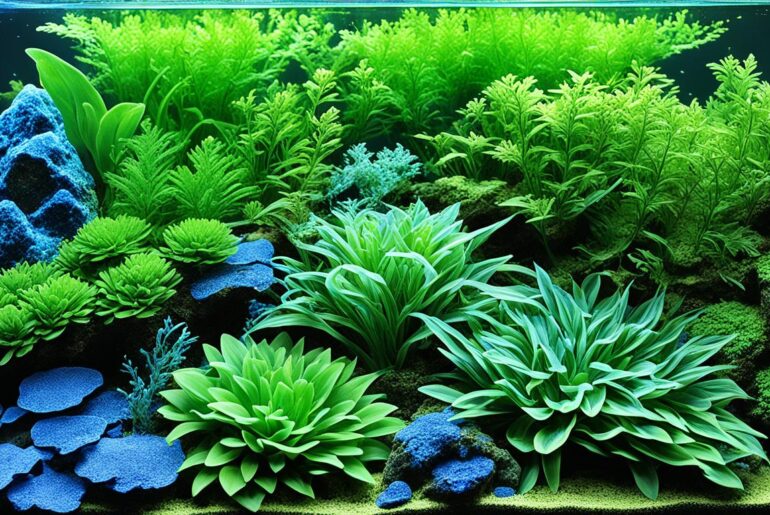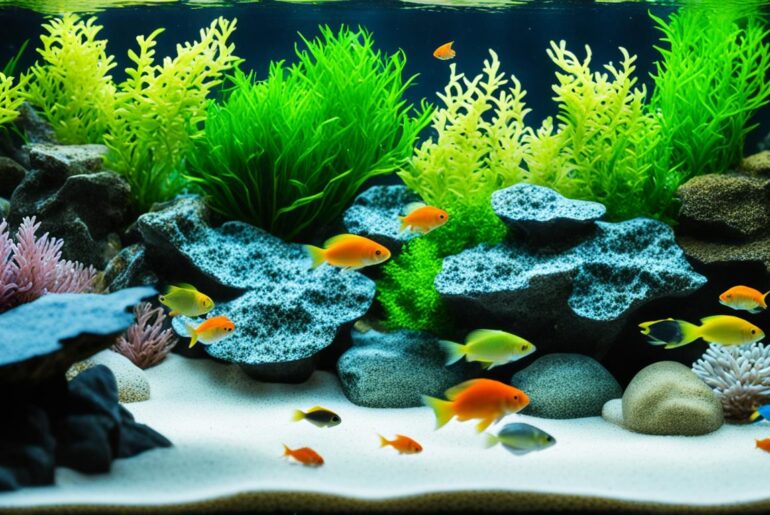As an avid aquarium enthusiast, I have always been captivated by the vibrant colors and intricate movements of freshwater shrimp. Watching these graceful creatures dart through the water brings me a sense of peace and joy. But I soon realized that creating the perfect environment for them goes beyond just providing clean water and a suitable diet. The substrate in the tank plays a crucial role in not only enhancing the aesthetic appeal but also ensuring the health and well-being of the shrimp.
Over the years, I have experimented with various substrates to find the optimal choice for different shrimp species. The journey has been filled with ups and downs, moments of success and lessons learned. In my quest to create the perfect shrimp tank, I have discovered the key factors that contribute to the thriving ecosystem that these delicate creatures deserve.
Key Takeaways:
- Choosing the right substrate is crucial for the health and well-being of freshwater shrimp.
- Neocaridina and Caridina shrimp have different substrate requirements.
- Inert substrates like sand and gravel are ideal for Neocaridina shrimp.
- Active soil substrates provide essential nutrients for Caridina shrimp and aquatic plants.
- Selecting the right substrate involves considering water parameters, plant requirements, and personal preferences.
Pros and Cons of Inert Substrates for Neocaridina Shrimp
When it comes to keeping Neocaridina shrimp, using inert substrates offers several advantages. Let’s take a closer look at the pros and cons of using these substrates:
Pros of Inert Substrates for Neocaridina Shrimp
- Inexpensive: Inert substrates such as sand, aquarium gravel, clay substrates, or crushed lava rock are affordable options for shrimp keepers on a budget.
- Stable water parameters: Unlike active soil substrates, inert substrates do not alter the water chemistry, providing a stable environment for Neocaridina shrimp.
- Easy to obtain: Inert substrates can be easily found at pet stores or online retailers, making them readily accessible to shrimp enthusiasts.
- Enhanced shrimp colors: Certain types of inert substrates, such as black sand, can enhance the vibrant colors of Neocaridina shrimp, adding visual appeal to your tank.
- Easy to clean: Inert substrates are generally easy to clean and maintain, requiring minimal effort to keep your shrimp tank looking pristine.
Cons of Inert Substrates for Neocaridina Shrimp
- Lack of essential nutrients: Inert substrates do not provide essential nutrients for aquatic plants. If you plan to have a heavily planted tank, additional fertilization may be necessary.
- Difficulty anchoring plants: Some types of inert substrates, especially fine sand, can be challenging for plants to anchor in. This may limit your options for planting or require additional measures to keep plants in place.
- Appearance variations: The appearance of inert substrates can vary depending on the type and brand. It’s important to choose a substrate that matches your desired aesthetic to create the look you envision for your shrimp tank.
- Potential compaction: Over time, fine sand substrates can become compact, making it difficult for plants to spread their roots and thrive in the tank. Regular substrate maintenance and occasional stirring can help prevent compaction.
While inert substrates have their advantages and disadvantages, they remain a popular choice for Neocaridina shrimp keepers looking for an affordable and low-maintenance option. If you prioritize stability, easy cleaning, and vibrant shrimp colors, inert substrates may be the right choice for your Neocaridina shrimp tank. Just keep in mind the potential limitations for plant growth and ensure proper fertilization if you decide to include aquatic plants in your setup.
Pros and Cons of Active Soil Substrates for Caridina Shrimp
When it comes to providing the ideal environment for Caridina shrimp, active soil substrates offer several advantages. These substrates are specially formulated to provide essential nutrients for aquatic plants and help lower and stabilize water parameters. They are enriched with trace minerals and humic substances that buffer the water to the preferred acidic range for Caridina shrimp, ensuring their optimal health and vitality.
One of the main benefits of active soil substrates is their ability to promote lush plant growth. The nutrient-rich composition of these substrates encourages vibrant and healthy aquatic plants, creating a visually appealing and natural underwater landscape. Additionally, the granular texture of active soil substrates allows for easy planting and rearranging, providing endless possibilities for designing your shrimp tank.
“Active soil substrates provide a nutrient-rich foundation for both plants and shrimp in the tank, creating a harmonious and thriving ecosystem.” – Expert Aquarist
However, there are a few considerations to keep in mind when using active soil substrates. Initially, these substrates may release ammonia into the water, which can be harmful to shrimp. To mitigate this, it is necessary to perform regular water changes to remove the excess ammonia. Additionally, the nutrient content of active soil substrates gradually decreases over time, necessitating the occasional replacement of the substrate to maintain optimal conditions for plant growth.
Another important factor to consider is the water source. The use of active soil substrates typically requires the use of RO-filtered water. This is because tap water often contains minerals and impurities that can interfere with the substrate’s buffering capabilities. Switching to RO-filtered water ensures that the active soil substrate can effectively maintain the desired water parameters for Caridina shrimp.
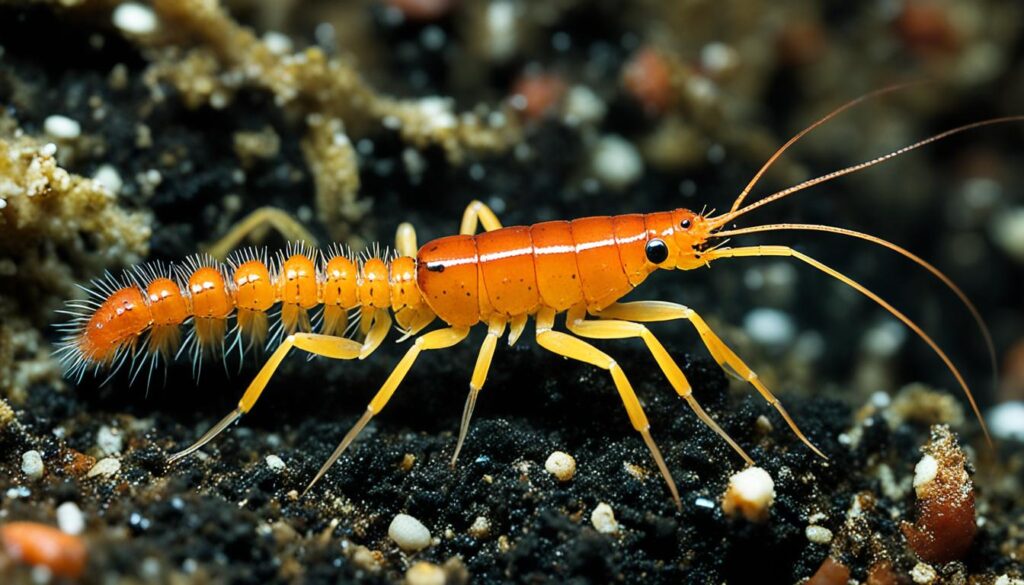
In summary, active soil substrates offer numerous benefits for Caridina shrimp tanks, including plant growth promotion, favorable water parameter regulation, and the creation of a visually appealing environment. However, they require additional care in terms of ammonia removal, nutrient replenishment, and the use of RO-filtered water. By understanding the pros and cons of active soil substrates, shrimp keepers can make informed decisions to provide the best possible habitat for their Caridina shrimp.
Using Active Soil Substrates with Neocaridina Shrimp
Neocaridina shrimp are incredibly adaptable and can thrive in a wide range of water parameters. While they typically do well with inert substrates like sand or gravel, using active soil substrates can provide additional benefits for their overall health and vitality. When incorporating active soil substrates into a Neocaridina shrimp tank, there are a few key considerations to keep in mind.
- Remineralize the water: Active soil substrates can lower the pH and soften the water, which may impact the availability of essential trace elements. To ensure the well-being of your Neocaridina shrimp, it’s important to remineralize the water with products specifically designed for shrimp tanks. This will help maintain stability and provide the necessary nutrients for your shrimp.
- Adaptation: Neocaridina shrimp are highly adaptable, but sudden changes in water parameters can be stressful for them. Breeding shrimp in water conditions similar to your own can help facilitate their adaptation to active soil substrates. Gradually acclimating them to the new substrate will give them time to adjust and thrive.
- Supplement substrate conditions: To further enhance the substrate conditions and promote plant growth, consider adding specialized products like SL-Aqua Milione or slow-release root tabs. These supplements can provide additional nutrients to support plant health and create a lush environment in tanks with inert substrates.
By taking these steps, you can successfully incorporate active soil substrates into your Neocaridina shrimp tank, providing them with a nutrient-rich environment and promoting the overall well-being of your shrimp and plants.
“Using active soil substrates can be a great way to enhance the health and vibrancy of Neocaridina shrimp tanks. They provide essential nutrients for plants and help create a stable environment for the shrimp. Just make sure to monitor water parameters and provide the necessary supplements to maintain optimal conditions for your shrimp.”
Using Inert Substrates with Caridina Shrimp
Caridina shrimp are known for their sensitivity to water parameters. They require a softer, more acidic water environment to thrive. While active soil substrates are recommended for Caridina shrimp tanks, it is possible to use inert substrates with proper care and adjustments. Although using inert substrates with Caridina shrimp may require more maintenance and attention, it can be done successfully.
One of the main challenges when using inert substrates with Caridina shrimp is maintaining the appropriate pH level. Caridina shrimp prefer a lower pH, typically between 6.0 and 7.0. To achieve this, several methods can be employed:
- Addition of tannins: Tannins can be introduced into the tank by using botanicals such as Indian Almond Leaves or Alder Cones. These release natural compounds that lower the pH and create a more suitable environment for Caridina shrimp.
- Use of peat underneath the substrate: Placing a layer of peat underneath the inert substrate can help lower and stabilize the pH level. The peat gradually releases acidic compounds that can create the desired water conditions for Caridina shrimp.
- pH/KH buffers: pH and KH buffers, such as those available in the aquarium market, can be used to adjust and maintain the pH level in a Caridina shrimp tank. These buffers help to stabilize the water conditions, reducing the risk of pH fluctuations that could stress the shrimp.
It is important to carefully monitor and maintain the pH level when using inert substrates with Caridina shrimp. Fluctuations or extreme pH levels can cause stress and health issues for the shrimp. Regular water testing and consistent adjustments are necessary to ensure a stable and suitable environment.
Although using inert substrates with Caridina shrimp requires more attention and maintenance compared to active soil substrates, it can still be a viable option. With the right adjustments and proper care, Caridina shrimp can thrive in tanks with inert substrates, allowing for a visually pleasing setup without compromising the health and well-being of the shrimp.
| Pros | Cons |
|---|---|
| 1. Inexpensive and readily available | 1. Lack of essential nutrients for plants |
| 2. Stable and easy to clean | 2. Difficulty in anchoring plants |
| 3. Enhances shrimp coloration | 3. Appearance may vary |
| 4. Suitable for Caridina shrimp with proper pH adjustments | 4. Fine sand substrates can become compact over time, making it challenging for plant spreading. |
Despite the challenges of using inert substrates with Caridina shrimp, diligent care and attention to water parameters can lead to successful shrimp keeping, allowing for a beautiful and vibrant tank.
Creating a Lush Planted Tank with Inert Substrates
When it comes to creating a stunning and vibrant planted tank, many aquarists opt for active soil substrates. However, it is entirely possible to achieve a lush planted tank using inert substrates. With the right techniques and supplements, you can create a thriving environment for both your plants and shrimp.
One important aspect to consider when using inert substrates is providing essential nutrients for your plants. While inert substrates don’t offer the same nutrient content as active soil substrates, you can supplement your soil with products like SL-Aqua Milione and root tabs. These nutrient supplements provide the necessary elements for healthy plant growth and vibrant colors.
To further stimulate plant growth in your inert substrate tank, consider implementing DIY CO2 and using liquid fertilizers. DIY CO2 systems provide a source of carbon dioxide that plants need for photosynthesis, promoting robust growth. Liquid fertilizers can be used to ensure your plants have access to essential nutrients.
While maintaining stability in water parameters is crucial for any planted tank, it becomes even more important when using inert substrates. Regular water testing and monitoring can help you make adjustments to maintain optimal conditions for your plants and shrimp.
“By adding nutrient supplements and maintaining stable water parameters, you can transform your inert substrate tank into a lush haven for both plants and shrimp.”
By incorporating these techniques into your tank maintenance routine, you can create a stunning and lush planted tank with inert substrates. The key is to provide the necessary nutrients and maintain optimal water conditions to support plant growth. With some patience and care, your plants will thrive, enhancing the overall beauty of your tank.
| Pros | Cons |
|---|---|
| • Inexpensive | • Lack essential nutrients for plants |
| • Stable and easy to clean | • Difficult to anchor plants |
| • Enhance shrimp colors | • Appearance may vary |
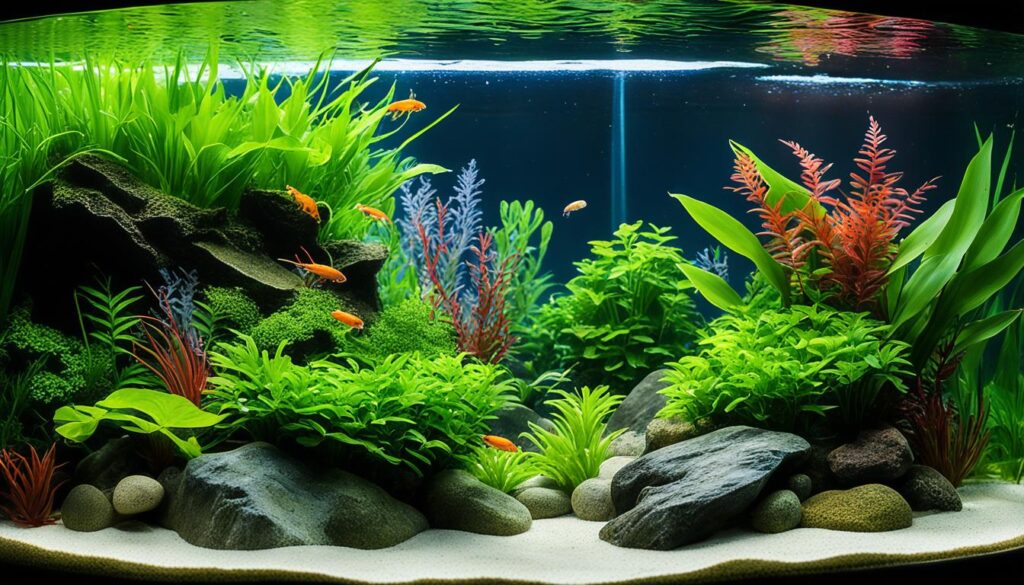
Benefits of Using Substrate in Shrimp Tanks
Using substrate in shrimp tanks provides a multitude of benefits that enhance the overall health and environment of the tank. Here are some key advantages:
- Biofilm Growth: Substrate provides a surface for biofilm growth, which is a vital food source for shrimp. The biofilm allows them to exhibit their natural foraging behavior, sifting through the substrate to find microscopic organisms to feed on.
- Habitat for Beneficial Bacteria and Detritus Worms: Substrate offers a living space for beneficial bacteria and detritus worms. These organisms play a crucial role in maintaining the tank’s ecosystem by breaking down waste and contributing to the biological filtration process.
- Aquatic Plant Growth: Substrate allows for the planting of aquatic plants in the shrimp tank. Plants not only enhance the aesthetic appeal of the tank but also provide additional benefits such as oxygenation, natural filtration, and shelter for the shrimp.
- Natural Look: Adding substrate to the tank creates a more natural and visually pleasing environment. It mimics the natural habitats of shrimp, making them feel more comfortable and less stressed.
- Stabilizing Water Parameters: Substrate helps stabilize water parameters by providing a medium for beneficial bacteria to thrive. These bacteria aid in the nitrogen cycle, converting harmful ammonia into less toxic substances, thereby maintaining water quality.
“Using substrate in a shrimp tank not only promotes the well-being of the shrimp but also creates a balanced and thriving ecosystem.”
Overall, the use of substrate in shrimp tanks is essential for creating a healthy, natural, and visually appealing environment. It offers numerous benefits, including facilitating shrimp behavior, supporting beneficial organisms, promoting plant growth, adding aesthetic value, and improving water stability.
Comparison of Using Substrate in Shrimp Tanks
| Benefits | Inert Substrates | Active Soil Substrates |
|---|---|---|
| Biofilm Growth | Yes | Yes |
| Habitat for Beneficial Bacteria and Detritus Worms | Yes | Yes |
| Aquatic Plant Growth | Yes | Yes |
| Natural Look | Yes | Yes |
| Stabilizing Water Parameters | Partial | Yes |
The table above summarizes the benefits of using both inert substrates and active soil substrates in shrimp tanks. While both types offer similar advantages, active soil substrates provide additional benefits for water parameter stabilization.
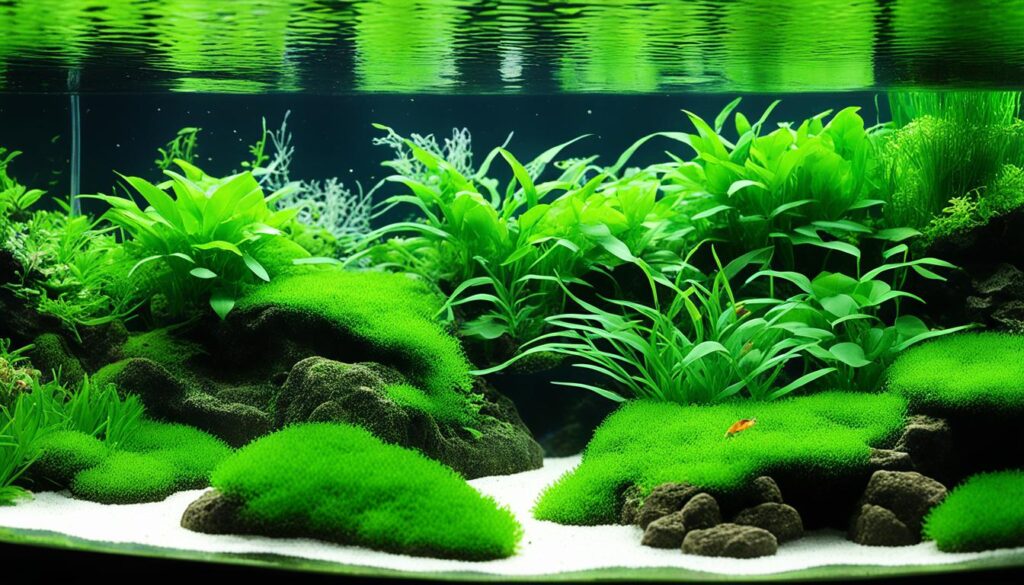
Types of Substrates for Shrimp Tanks
When it comes to setting up a shrimp tank, choosing the right substrate is essential for creating a healthy and thriving environment. There are several types of substrates available, each with its own advantages and considerations.
1. Gravel: Gravel is a popular choice for shrimp tanks due to its affordability and availability. It comes in various sizes and colors, allowing for customization and aesthetic appeal. However, gravel lacks nutrient content and can accumulate pockets of anaerobic gas if not properly maintained.
2. Sand: Sand is a finer substrate that is easier for shrimp to sift through, mimicking their natural foraging behavior. It provides a more natural look to the tank and is suitable for shrimp species that prefer soft substrate. However, sand can lead to compacted areas and nutrient deficiency for planted tanks. It requires regular maintenance to prevent compaction and ensure proper water flow.
3. Active Substrates: Active substrates, such as ADA Aquasoil and Akadama, offer a wide range of benefits for shrimp tanks. They are specifically designed to regulate water chemistry by lowering pH and softening water, creating ideal conditions for shrimp. These substrates also provide essential nutrients for plant growth and act as a biological filtration medium, supporting the growth of beneficial bacteria.
Here is a comparison table highlighting the characteristics of each substrate:
| Substrate Type | Advantages | Considerations |
|---|---|---|
| Gravel | Affordable and customizable | Lacks nutrient content, potential for anaerobic gas pockets |
| Sand | Mimics natural foraging behavior, suitable for soft substrate species | Can lead to compaction and nutrient deficiency if not properly maintained |
| Active Substrates | Regulates water chemistry, enriches nutrient supply for plants, supports biological filtration | Higher cost, may require specialized water preparation |
Note: The attributes mentioned above are general characteristics and may vary depending on the specific brand and product.
Ultimately, the choice of substrate depends on your shrimp species, desired water parameters, and planted tank requirements. It is important to research and understand the specific needs of your shrimp to make an informed decision.
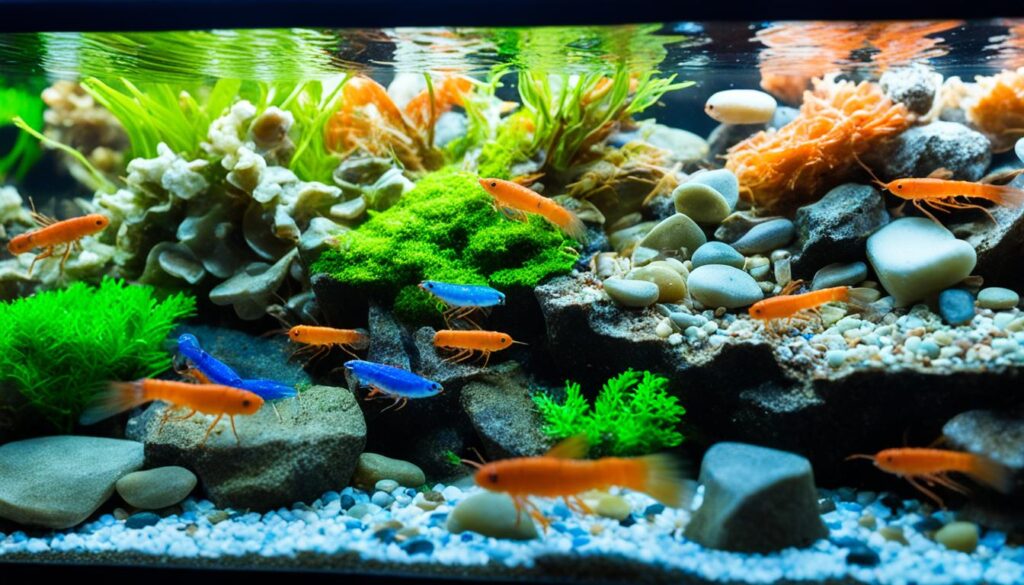
With the right substrate in place, you can create a suitable environment for your shrimp to thrive and exhibit their natural behaviors. Whether you opt for gravel, sand, or active substrates, remember to regularly monitor and maintain the tank to ensure the well-being of your shrimp.
Benefits of Active Substrates for Shrimp Tanks
Active substrates offer numerous benefits for shrimp tanks, enhancing both the water chemistry and the overall well-being of the inhabitants. Let’s explore some key advantages:
- pH Regulation and Water Softening: Active substrates play a vital role in regulating the pH levels of the water. They have the ability to lower the pH, creating a more suitable environment for many shrimp species. Not only that, but these substrates also contribute to water softening, which is important for the health and breeding success of the shrimp.
- Nutrient Supply for Plant Growth: Active substrates provide essential nutrients for aquatic plants, promoting healthy growth and vibrant foliage. The enriching soil composition of these substrates ensures that plants receive the necessary elements to flourish in the shrimp tank environment.
- Beneficial Bacteria Habitat: Active substrates offer a perfect home for beneficial bacteria, which are crucial for biological filtration. These bacteria help break down organic waste, keeping the tank water clean and ensuring optimal water quality for the shrimp.
- Enhanced Comfort and Foraging: The granular texture of active substrates enhances the comfort of the shrimp, allowing them to sift through the substrate with ease. This natural behavior not only provides enrichment but also supports their foraging instincts, as they can search for food particles hidden within the substrate.
To further illustrate the benefits of active substrates, take a look at the table below:
| Benefits of Active Substrates for Shrimp Tanks | Illustration |
|---|---|
| Regulation of pH and water softening | 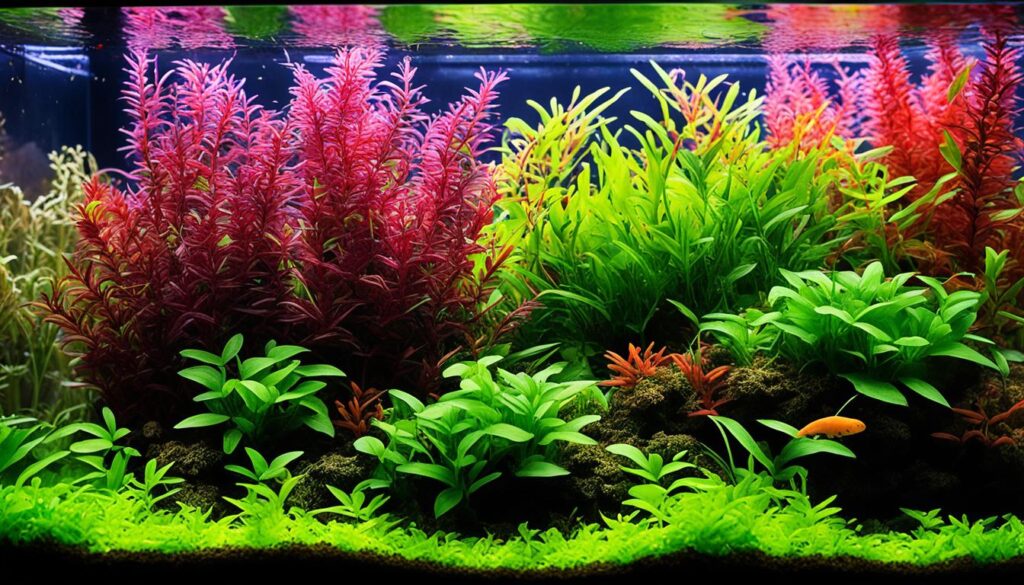 |
| Nutrient supply for plant growth |  |
| Habitat for beneficial bacteria |  |
| Enhanced comfort and foraging behavior |  |
As evident from the table, active substrates provide a comprehensive solution for maintaining a healthy and thriving shrimp tank. They contribute to water chemistry regulation, promote plant growth, support biological filtration, and enhance the overall well-being of the shrimp.
Step-by-Step Guide to Installing Substrate in a Shrimp Tank
Installing substrate in a shrimp tank is a crucial step in creating a healthy and aesthetically pleasing environment for your shrimp. Follow this step-by-step guide to ensure a successful installation:
- Choose the right substrate: Consider the specific needs of your shrimp species and the desired water parameters. Selecting the appropriate substrate, whether inert or active soil, is essential for their well-being.
- Rinse the substrate: If using inert substrates such as sand or gravel, rinse them thoroughly to remove any dust or debris. This will prevent cloudiness in the water once added to the tank.
- Add the substrate: Carefully pour the substrate into the tank, creating a leveled layer. The depth of the substrate will depend on the species of shrimp and the desired aesthetic.
- Shape the substrate: Use your hands or a gentle slope to create different levels or areas within the tank. This serves both aesthetic and functional purposes, providing hiding spots and planting areas for aquatic plants.
- Slowly add water: Gradually fill the tank with water to avoid disturbing the substrate. Pouring the water onto a plate or using a water conditioner bottle can help prevent displacement of the substrate.
- Cycle the tank: Before adding shrimp to the tank, it is crucial to cycle the tank to establish a healthy bacterial colony. This process typically takes a few weeks and involves monitoring the water parameters to ensure they are suitable for shrimp.
By following these steps, you can ensure a smooth installation of substrate in your shrimp tank, providing a comfortable and thriving environment for your shrimp.
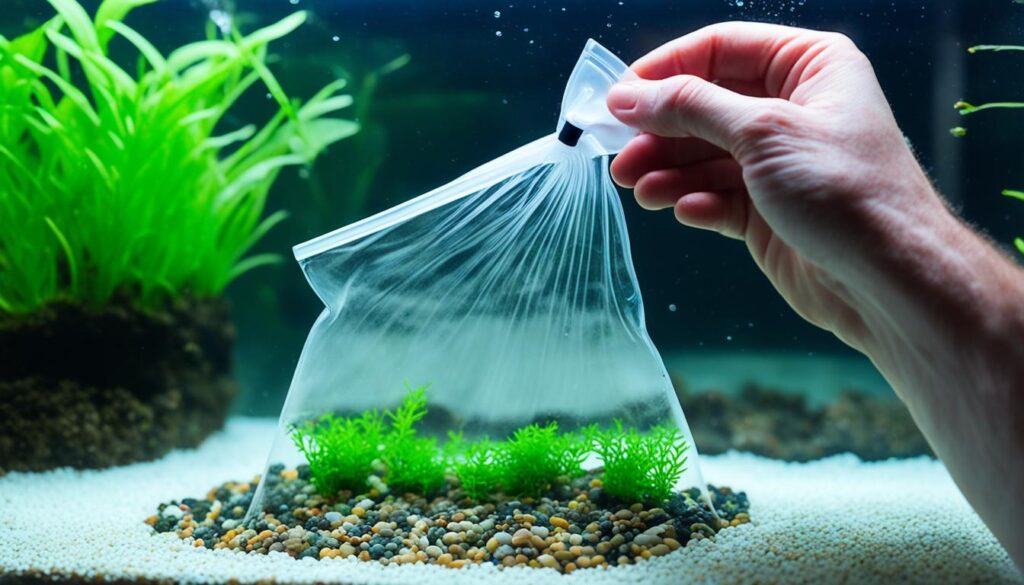
Conclusion
When it comes to choosing the optimal substrate for your freshwater shrimp tanks, it is important to consider the specific needs of your shrimp species and the desired environment. Neocaridina shrimp thrive on inert substrates such as sand, aquarium gravel, clay substrates, or crushed lava rock. These options are affordable, stable, and do not alter water chemistry.
On the other hand, Caridina shrimp benefit from active soil substrates that provide specific nutrients for aquatic plants and help maintain the desired water parameters. Active soil substrates, such as UNS Controsoil, Tropica Aquarium Soil, and Aquario Neo Shrimp Soil, offer advantages in terms of plant growth and water chemistry regulation.
When selecting a substrate, it is important to consider factors such as water parameters, plant requirements, and personal preferences. Proper installation and maintenance of the substrate play a crucial role in the overall health and happiness of the shrimp in the tank. By carefully choosing and caring for the substrate, you can create a thriving environment for your freshwater shrimp tank.
FAQ
What types of substrates are suitable for freshwater shrimp tanks?
There are two main types of substrates for shrimp tanks – inert substrates and active soil substrates. Inert substrates include sand, aquarium gravel, clay substrates, or crushed lava rock. Active soil substrates, such as UNS Controsoil, Tropica Aquarium Soil, and Aquario Neo Shrimp Soil, provide specific nutrients for aquatic plants and help maintain water parameters for shrimp.
What are the advantages of using inert substrates for Neocaridina shrimp?
Inert substrates are affordable, stable, and do not alter water chemistry. They are easy to clean and enhance the coloring of the shrimp. However, they lack essential nutrients for aquatic plants and may be difficult to anchor plants in.
What are the advantages of using active soil substrates for Caridina shrimp?
Active soil substrates provide essential nutrients for plants, help lower and stabilize water parameters, and offer a home for beneficial bacteria crucial for biological filtration. They also allow for landscape designs and easy planting of aquatic plants.
Can I use active soil substrates with Neocaridina shrimp?
Yes, you can use active soil substrates with Neocaridina shrimp. However, it is important to remineralize the water to provide necessary trace elements and maintain stability. Breeding shrimp in water parameters similar to your own can aid in their adaptation.
Can I use inert substrates with Caridina shrimp?
Yes, you can use inert substrates with Caridina shrimp, but it requires more maintenance. Lowering the pH can be achieved through the addition of tannins, peat, or pH/KH buffers. It is important to keep the pH stable to prevent stress on the shrimp.
How can I create a lush planted tank using inert substrates?
Adding nutrient supplements to the soil, using CO2 and liquid fertilizers, and maintaining stability in water parameters can result in a thriving environment for both plants and shrimp in a tank with inert substrates.
What are the benefits of using substrate in shrimp tanks?
Substrate provides a surface for biofilm growth, offers living space for beneficial bacteria and detritus worms, allows for planting of aquatic plants, creates a more natural look, and helps stabilize water parameters. It also contributes to the comfort and foraging behavior of shrimp.
What are the different types of substrates available for shrimp tanks?
The main types of substrates for shrimp tanks include gravel, sand, and active substrates. Gravel is affordable but lacks nutrient content. Sand is finer and easier for shrimp to sift through but can lead to compacted areas. Active substrates, such as ADA Aquasoil and Akadama, regulate water chemistry, provide nutrients for plants, and offer biological filtration.
What are the benefits of using active substrates for shrimp tanks?
Active substrates contribute to the regulation of water chemistry, provide essential nutrients for plant growth, and offer a home for beneficial bacteria crucial for biological filtration. They also enhance the comfort and foraging behavior of shrimp.
What is the step-by-step guide to installing substrate in a shrimp tank?
The process involves choosing the right substrate, rinsing the substrate if necessary, adding it to the tank, shaping the substrate, and slowly adding water. It is important to cycle the tank before adding shrimp to establish a healthy bacterial colony.
What is the optimal substrate for freshwater shrimp tanks?
The optimal substrate for freshwater shrimp tanks depends on the specific needs of the shrimp species and the desired environment. Neocaridina shrimp thrive on inert substrates, while Caridina shrimp benefit from active soil substrates. Proper installation and maintenance contribute to the overall health and happiness of the shrimp in the tank.
